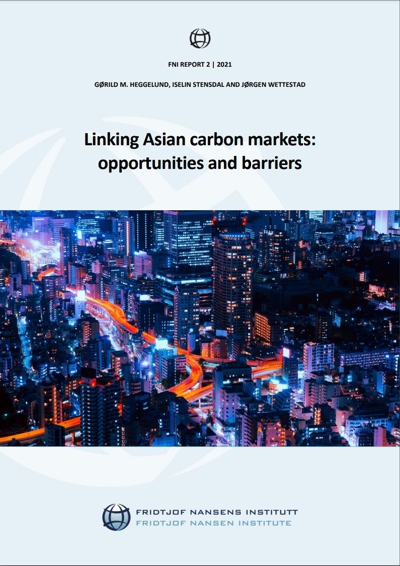Publication: Linking Asian carbon markets: opportunities and barriers
To download the publication please click on the download link at the bottom of the page
Authors: Gørild M. Heggelund / Iselin Stensdal / Jørgen Wettestad
CNARC member: Fridtjof Nansen Institute (FNI)
Abstract: Northeast Asian countries are emerging as major players in development and operation of carbon markets. Already connected through economic ties, these countries also share environmental challenges. Expert reports have therefore called for the countries to link their respective carbon markets, as this could offer economic, environmental, and strategic benefits.
With this report we offer an overview of the status of carbon markets in key economies in Asia today. Our main focus is China, Japan and South Korea, but we also cover Kazakhstan. All four countries have developed and operated carbon markets. This report identifies positive experiences as well as existing bottlenecks and barriers to a possible future linking of carbon markets among these countries. We also give a brief introduction to markets that are running, planned or have been shelved in the Asia-Pacific region.
The report looks into the following aspects: what is the status of carbon markets in these key economies; what are key general lessons about the linking of carbon markets so far; what are the main similarities and differences between main Asian carbon markets; what are key challenges and prospects for a linked North Asian carbon market.
We find that countries are increasingly showing interest in employing market mechanisms to control GHG emissions. From a global framework perspective, the upcoming COP26 in Glasgow 2021 may contribute to setting the stage for international carbon trading. We note positive trends and opportunities for linking between carbon markets in North East Asia. A pull in a positive direction is that Japan, South Korea and China initiated academic exchanges on potential for linking emissions trading systems in the future; and they already have various types of carbon markets at the national or subnational level. Japan, South Korea and China all have carbon-neutrality goals (of 2050, 2050 and 2060 respectively), which may provide an incentive to explore the possibilities of linking carbon markets. We find that an ETS linking between Korea and China appears more feasible, given the many similarities between the national schemes. However, considerable differences remain in policy design and implementation status: the carbon markets differ in size, structures, design, and the markets are at different stages of development.
Finally, the report has highlighted the need for a deeper understanding of several aspects of carbon-market linkage. Establishing a North East Asian regional carbon market hub could have economic, environmental, and strategic benefits for the region, as well as globally. Further in-depth study is needed of how to resolve the challenges involved in linking differently structured, designed and functioning markets.


